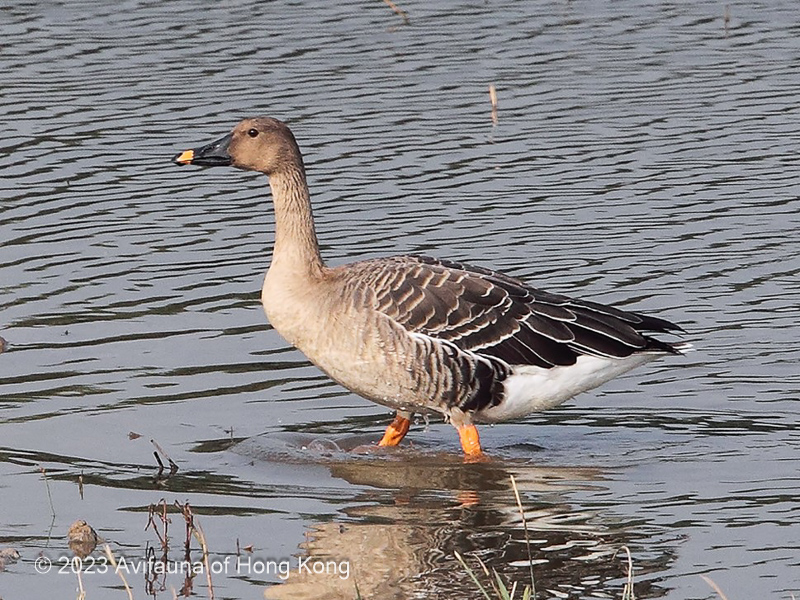Taiga Bean Goose Anser fabalis 寒林豆雁
Category I. Accidental.
IDENTIFICATION

Nov. 2010, Michelle and Peter Wong.
76-89 cm. Closely resembles Tundra Bean Goose but differs in larger size, longer body, longer and more slender neck, and longer forehead that has a smoother line with the more tapered bill, which together can impart a resemblance to Whooper Swan. The eye is relatively close to the forehead. The bill is black, usually with a small orange patch near tip.

Oct. 2020, Kenneth Lam.
The dark head and neck contrast with the pale belly.
VOCALISATIONS
Usual call is deep and disyllabic or trisyllabic.
DISTRIBUTION & HABITAT PREFERENCE
Recorded in the intertidal area, ponds and gei wai of Mai Po NR.
OCCURRENCE
2010: two at Mai Po NR from 3 November to 22 February 2011 (Ko 2012).
2020: two at Mai Po during 8-28 October.
BEHAVIOUR, FORAGING & DIET
Observed feeding on aquatic vegetation.
RANGE & SYSTEMATICS
Three subspecies are recognised, with that occurring in HK presumed to be A. f. middendorffii, which breeds in east Siberia; A. f. johanseni breeds in west Siberia and the nominate form breeds from Scandinavia to north central Siberia. Not all authorities split Taiga Bean Goose and Tundra Bean Goose.
Breeds in taiga zone from Scandinavia to Chukotka and winters in central and southern Europe, Central Asia and east Asia, the latter supporting most of the population of A. f. middendorffii (Carboneras and Kirwan 2020). In China A. f. middendorffii is a migrant through the north and northeast and winters in south China though generally does not reach the coast (Liu and Chen 2020).
CONSERVATION STATUS
IUCN (treats A. fabalis and A. serrirostris as single species): Least Concern. Population trend decreasing.
Carboneras, C. and G. M. Kirwan (2020). Taiga Bean-Goose (Anser fabalis), version 1.0. In Birds of the World (S. M. Billerman, B. K. Keeney, P. G. Rodewald, and T. S. Schulenberg, Editors). Cornell Lab of Ornithology, Ithaca, NY, USA. https://doi.org/10.2173/bow.taibeg1.01
Ko, K. (2012). Taiga Bean Goose Anser fabalis at Mai Po Nature Reserve. The first Hong Kong record. Hong Kong Bird Report 2009-10: 230-232.
Liu, Y. and Y. H. Chen (eds) (2020). The CNG Field Guide to the Birds of China (in Chinese). Hunan Science and Technology Publication House, Changsha.

